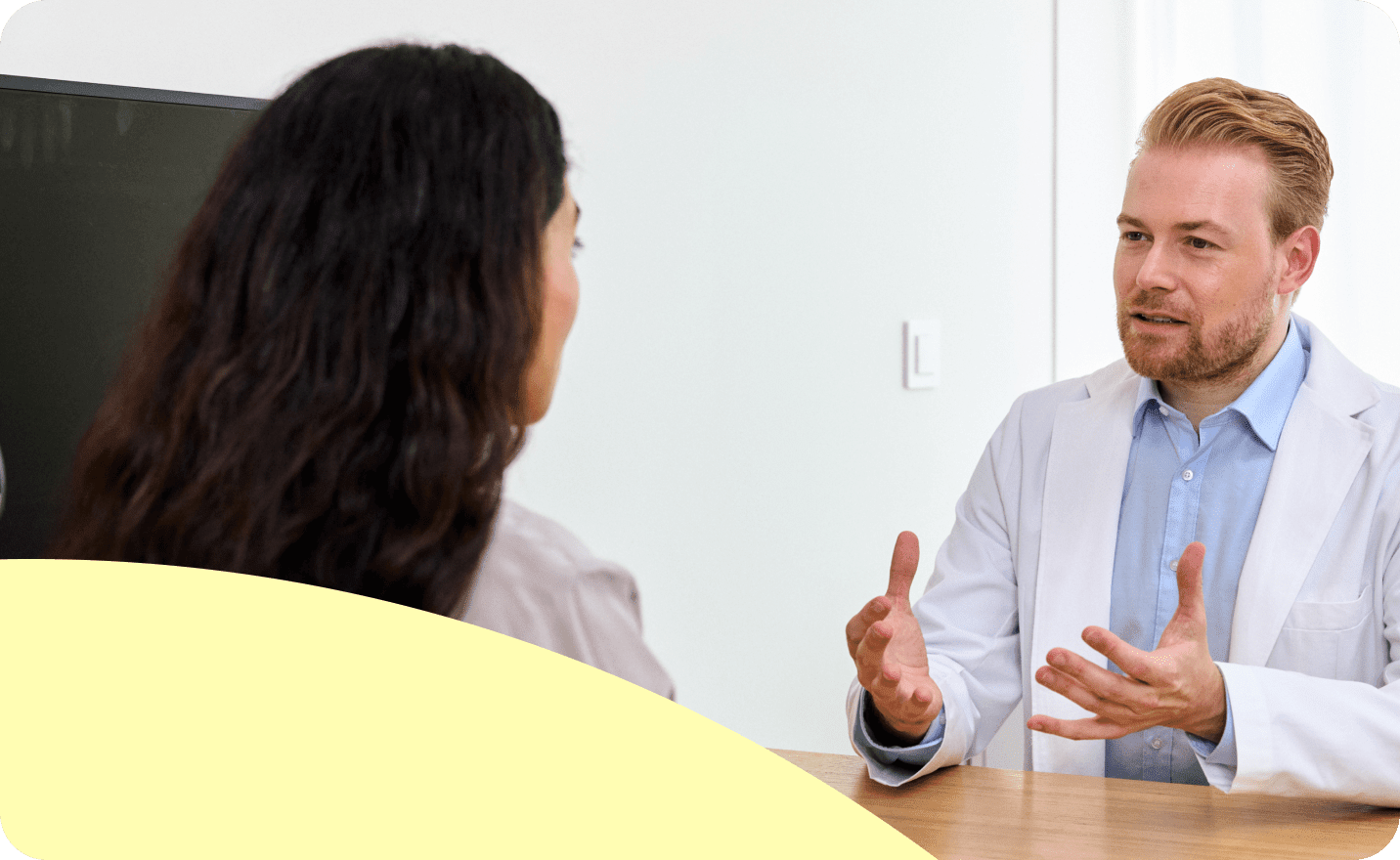Find out why the question "Am I pregnant?" can only be clarified after a two-week waiting period with a pregnancy test.
After going through assisted fertilisation, such as in vitro fertilisation (IVF) or intrauterine insemination (IUI), waiting for result of the pregnancy test can be stressful. On the one hand, it is an exciting and hopeful part of the treatment cycle; on the other hand, it is often associated with uncertainty and fear.
In this article you will learn why it is recommended to wait two weeks after ovulation for a pregnancy test, how to get through this waiting period and what signs of pregnancy may appear.
How does a pregnancy test work?
A pregnancy test is a quick and easy way to determine if you are pregnant. Although different tests have different levels of sensitivity, they are all based on detecting the hormone hCG in a woman's urine or blood.
Typically considered a pregnancy hormone, hCG doubles every two to three days in the first few weeks of pregnancy. Production only increases after the fertilised egg has implanted itself in the lining of the uterus (also called the endometrium). This hormone is first produced by cells surrounding the developing embryo. These later develop into the placenta, which then continues to produce hCG. HCG stimulates the corpus luteum (a temporary gland) to produce progesterone, which maintains the pregnancy during the first 12 weeks. After this time, the placenta takes over progesterone production.
There are two main types of pregnancy tests:
Urine tests. Urine tests are the most common type of pregnancy test that can be done in the comfort of your own home or at a clinic. The test strip contains antibodies that react specifically to hCG. When a woman puts her urine on the test strip, the antibodies can recognise the hCG; if enough hCG is present, a reaction is triggered. This reaction shows up as lines or symbols on the test strip.
Depending on the brand of home pregnancy test, the reactions can be displayed differently; each pregnancy test typically has one line that is always present. This line is a control, meaning it shows that the strip is working properly. The presence of a second line or symbol usually indicates a positive test result, meaning a pregnancy. Most fertility clinics recommend that the test be performed no earlier than the first day of the new cycle (or 14 days after the fertilised egg has been inserted into the uterus).
Blood tests. Blood tests may be done by a doctor or at a medical facility. There are two types of blood tests: qualitative and quantitative. The qualitative blood test only confirms the presence of hCG in the blood, while the quantitative blood test measures the exact level of hCG. Blood tests are considered more sensitive than urine tests and can often detect pregnancy earlier.
When is a pregnancy test performed after assisted reproduction?
The concentration of hCG in the blood increases steadily in the first few weeks of pregnancy. After a two-week waiting period, a blood test can be carried out at the fertility clinic to determine pregnancy. This two-week waiting period (TWW) takes into account the time it takes for a fertilised egg to successfully implant in the lining of the uterus. It also increases the likelihood that the test will provide an accurate result, as it allows for any fluctuations in hCG levels to be smoothed out beforehand.
With an IUI, the sperm are inserted into the uterus at the time of ovulation. The sperm must then swim to the fallopian tubes to fertilise an egg. The fertilised egg then travels to the uterus, where it can implant in the endometrial tissue. Similar to unassisted insemination, implantation with IUI can take place between 6–12 days after the procedure.
In the fertility treatment in vitro fertilisation (IVF), the egg cell is fertilised outside of the female body and left to develop for a couple Days. The embryo is then transferred to the uterus between days 3 to 5 of its development. It may then successfully implant a day or two later, at which point the production of hCG begins.
Timing of implantation may vary depending on whether additional techniques, such as assisted hatching, are used. 'Assisted hatching' is a method designed to help the eggs break through their protective shell and successfully embed in the uterus. In this procedure, a small opening is made in the egg shell to help the eggs hatch. This occurs on the day of the embryo transfer with a precise laser beam under the microscope.
Does an early test make sense?
In the case of artificial insemination, doctors recommend only carrying out a test two weeks after the procedure in order to get a reliable result. The main reason for an incorrect result is testing too early. The test can be false negative and sometimes false positive.
- False negative: The result of the pregnancy test is negative, although you are pregnant. This may be because the pregnancy test was taken too early, and the value of the hCG hormone is still below the detection limit of the test.
- False positive: You may have received a positive pregnancy test, but implantation has not occurred or the implanted egg is not developing. It can also be caused by taking medication to induce ovulation.
Although early testing is discouraged, some women or couples may wish to test during the TWW to help manage their fears or feelings. In this case, please note that the test result may be inaccurate.
What should I watch out for before taking the test?
During the TWW, the 'all or nothing' principle applies. It is recommended that you assume that you are pregnant during this time and behave or adjust your lifestyle accordingly until you receive a negative or positive result. That means protecting yourself from harmful influences, such as not drinking alcohol, avoiding smoking, or not starting a strenuous new fitness program.
Tips for coping with the two-week wait
The two-week wait can be an exciting but stressful time. We've collected some advice that can help you cope better as you wait to test for early pregnancy.
Emotional support
It's normal for you to feel a variety of emotions during this time, from hope and anticipation to fear and uncertainty. Talk to your partner, family or close friends about your feelings and fears. Trusting those you feel comfortable with to provide you with empathy and support can be enormously helpful in overcoming the emotional burden.
Distraction and self care
Try to actively distract yourself while you wait and focus on activities that are good for you. Take care of your physical and mental health by exercising regularly, practicing relaxation techniques, such as meditation or yoga, and getting enough sleep. Indulge in things that bring you joy, such as reading a good book, watching a movie, or spending time in nature. Conscious self-care can help you control your thoughts about the pregnancy test and reduce stress.
Avoid too much research
It is understandable that during this nerve-wracking time you are looking for information and want answers to your questions. However, avoid the temptation to spend too much time on the internet looking for possible symptoms that might indicate the onset of pregnancy. Every body and pregnancy is unique, and excessive Googling can lead to confusion and added stress.
Find support among like-minded people
It can be helpful to connect with other couples or people going through similar experiences. For example, you can look for self-help groups, online forums, or specialised communities where you can exchange ideas and ask your questions. Joining a support group may help you to feel less alone. In addition, being able to exchange ideas with others can be encouraging and give you additional support.
When do you notice the first early pregnancy symptoms and what do they feel like?
Signs of pregnancy usually appear in the first trimester of pregnancy. In the first two weeks after fertilisation, the fertilised egg implants and only then does the body begin to produce hCG. As soon as the hormonal balance has changed and the body recognises that it is pregnant, the first signs of pregnancy can become apparent.
Women may experience physical symptoms after assisted reproduction and before taking a pregnancy test. These can already be the first signs of pregnancy, although they can also be very similar to symptoms of an impending period. If you are receiving hormone treatments to encourage egg development and implantation, such as ovarian stimulation and progesterone, you may feel some pain. Some women also experience implantation pain, which feels like uterine cramping. However, it is also often the case that the woman has no symptoms at all in the first few weeks after artificial insemination.
Two weeks after fertilisation, many women experience the clearest pregnancy symptom: the missed period. In addition to this, they may have some of the following common symptoms:
- Missed period: Missing a period is often one of the first signs of pregnancy. The body begins to change hormonally and the menstrual period stops.
- Breast tenderness and tightness: In the early weeks of pregnancy, breasts can become more tender and heavier. A feeling of tension or slight pain may occur.
- Nausea and vomiting: Many women experience nausea during the first few weeks of pregnancy (up to around 80% according to one study), especially in the mornings. This symptom is often referred to as 'morning sickness,' but it can occur at any time of the day. Some women also report sensitivity to smells.
- Frequent urge to urinate: Another sign of pregnancy is an increased urge to urinate. It is caused by increased blood flow to the abdomen after implantation of the fertilised egg cell. The pregnancy hormone progesterone also relaxes the bladder muscles, which increases the urge to urinate.
- Fatigue: The hormonal changes in the body during pregnancy can lead to increased fatigue. It could be that you feel constantly exhausted and need more sleep.
- Food cravings: It is often said that sudden and intense cravings for certain foods can be an early sign of pregnancy. However, it has not yet been scientifically proven that food cravings are a symptom of pregnancy.
- Mood swings: The hormonal roller coaster of pregnancy can lead to mood swings. You may be feeling more emotional or moody than usual.
- Changes in vaginal discharge: Some women notice changes in vaginal discharge, which can become thicker and milkier during pregnancy.
- Light bleeding or spotting: Some pregnant women experience light bleeding or spotting in the early weeks of pregnancy. This is often referred to as implantation bleeding and occurs when the fertilised egg implants in the wall of the uterus.
The above signs of conception are only possible indications, and they can vary from woman to woman. While confusing, many of these symptoms can also correspond with premenstrual syndrome (PMS). In order to get an accurate diagnosis, it is advisable to see your gynecologist and do a pregnancy test.
To read more about why PMS and pregnancy have similar symptoms, take a look at our blog article.
Conclusion
For many women and couples, the two-week wait after assisted reproduction is a time of uncertainty over which they have no control. During this phase, the fertilised egg may implant in the uterus, leading to the early stages of pregnancy. This period of waiting can be perceived as stressful and burdensome. It can help to look after your own well-being and enlist the support of friends and family during this waiting period.
During the first two weeks after an ART prodcedure, levels of hCG may not be high enough to be detected by a pregnancy test. That is why gynecologists recommend that a blood test be carried out after two weeks. Physical symptoms can also be an indicator, but not yet proof of pregnancy.
Would you like to know more about assisted fertilisation procedures? Then contact Cada. Our team of specialists will be happy to help you with any questions you may have about fertility. Reserve your spot for a personalised consultation today.







